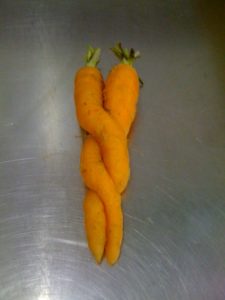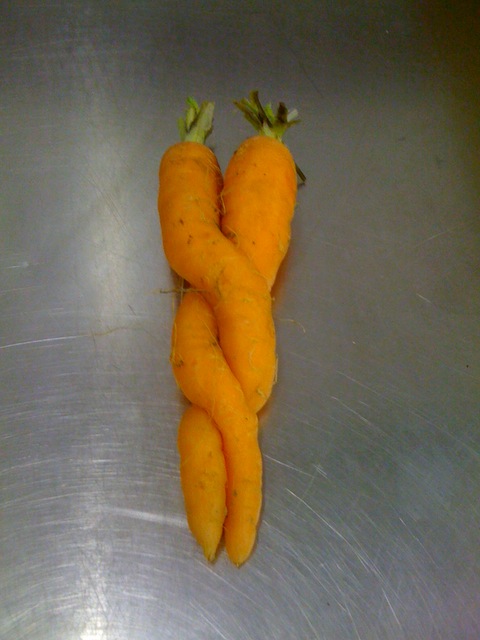Belonging to a CSA provides a new learning experience for all of us. In most CSAs, members join with a single farm to share the risk of the growing season, being subject to the limitations of the farm’s diversity, as well as to the possibility of crop failure or poor yields caused by heat or drought. The risk also tips in the other direction–sometimes there’s an abundance of a single crop, such as collards or beets, and many a CSA member has lamented getting four-consecutive weeks of five heads of cabbage. This teaches us about the risks that farmers take, the difficulty involved in growing produce, the toll that weather takes on crops, and the importance of having a good stock of recipes and cooking creativity on hand!
Generally, Fair Shares isn’t subject to these problems due to our size and number of producers, but we do try to help the farmers by purchasing the excess, including the ugly, or paying more for certain items that had a bad yield, so that the farmer doesn’t lose too much. Another thing being involved in a CSA teaches us is what it means to eat seasonally. As grocery store shoppers, we took for granted the abundance and availability of everything year round–asparagus in the fall, strawberries in the winter, apples in the spring. That’s not how things grow locally, although the onslaught of hoop houses is certainly extending the growing season for many crops. There are crops that are springtime only—asparagus and strawberries, for instance; and others that are planted twice to have both a spring and fall harvest, such as broccoli, turnips, lettuces, and carrots, to name a few. Some things only do really well in the summer, like corn and cucumbers, while others, like lettuce greens, can’t take the heat. Apples are ready in the mid summer and fall, and any apples you get in the spring have been in storage since the fall. This knowledge adds excitement and anticipation to each season as we await the harvest of certain favorites, and this makes everything taste better (absence makes the heart grow fonder, no?).
Another thing being involved in a CSA teaches us is what it means to eat seasonally. As grocery store shoppers, we took for granted the abundance and availability of everything year round–asparagus in the fall, strawberries in the winter, apples in the spring. That’s not how things grow locally, although the onslaught of hoop houses is certainly extending the growing season for many crops. There are crops that are springtime only—asparagus and strawberries, for instance; and others that are planted twice to have both a spring and fall harvest, such as broccoli, turnips, lettuces, and carrots, to name a few. Some things only do really well in the summer, like corn and cucumbers, while others, like lettuce greens, can’t take the heat. Apples are ready in the mid summer and fall, and any apples you get in the spring have been in storage since the fall. This knowledge adds excitement and anticipation to each season as we await the harvest of certain favorites, and this makes everything taste better (absence makes the heart grow fonder, no?).
As we taste the amazing flavors that develop when produce is allowed to ripen fully before picking, we start to understand the value of eating locally. Our food doesn’t need to be picked green in order to be shipped across the country or continent. This also allows the plant to develop more nutrients, making it both more satisfying to our bodies and more flavorful to the palate. The downside of this is twofold. First off, ripe produce, such as tomatoes and peaches, often have a short shelf life, because they continue to ripen off the vine and tree, often very quickly with the excessive temperatures here. The second negative is that it makes us completely spoiled, and can downright ruin the enjoyment of food that is not grown to these standards.
An important lesson to learn in being part of this CSA is that we don’t purchase the food in excess, as a grocery store does, to allow for lots of waste or damage. We purchase what we need for the shares in order to keep the price as low as possible. This means you must do an assessment right away of the food you receive, to determine what needs to be used first. If anything has a spot, or is split, cut it off and use it quickly–the rest of the vegetable is perfectly fine, but it won’t be in a day or two. This is what we and the farmers eat, and although we try to have beautiful and perfect produce for the members, sometimes a stem will get knocked off or poke through another piece in travel, or a delicate peach or tomato will be bruised or split. It doesn’t make the whole thing compost, though! There are reasons great, local food isn’t cheaper than the grocery store. One reason is economy of scale–it’s just cheaper for a giant operation than it is for a small family farmer. Another is because the farmers are letting the food ripen fully on the plant, and so they are subject to a smaller yield, for a couple of reasons. One, ripe produce is more appealing to bugs, and two, it damages easily or gets overripe quickly, and then they can’t sell it. It’s a thin line, and one we see particularly with the heirloom tomatoes. This is the reason you almost never see heirloom varieties of produce at a grocery store. Besides the fact that heirlooms generally don’t produce like the hybrid varieties bred for quantity, not quality, they are fragile and don’t travel well. They crack on the vine, and the awkward shapes often lead them to bruise easily. But they are so delicious. When we get them in from the farmers, they may be perfect or even slightly under ripe. Sometimes it is the day before pickups, sometimes the same afternoon, and by the time we give them out, already they may be splitting and oozing. It’s just the nature of the beast. Cut off the bad part, get out the salt and eat it now! This is also why we can’t allow you to touch the tomatoes (or peaches) to select them–one extra squeeze and that baby’s going in a bloody Mary (or daiquiri). If it’s too soft to slice, make gazpacho!
There are reasons great, local food isn’t cheaper than the grocery store. One reason is economy of scale–it’s just cheaper for a giant operation than it is for a small family farmer. Another is because the farmers are letting the food ripen fully on the plant, and so they are subject to a smaller yield, for a couple of reasons. One, ripe produce is more appealing to bugs, and two, it damages easily or gets overripe quickly, and then they can’t sell it. It’s a thin line, and one we see particularly with the heirloom tomatoes. This is the reason you almost never see heirloom varieties of produce at a grocery store. Besides the fact that heirlooms generally don’t produce like the hybrid varieties bred for quantity, not quality, they are fragile and don’t travel well. They crack on the vine, and the awkward shapes often lead them to bruise easily. But they are so delicious. When we get them in from the farmers, they may be perfect or even slightly under ripe. Sometimes it is the day before pickups, sometimes the same afternoon, and by the time we give them out, already they may be splitting and oozing. It’s just the nature of the beast. Cut off the bad part, get out the salt and eat it now! This is also why we can’t allow you to touch the tomatoes (or peaches) to select them–one extra squeeze and that baby’s going in a bloody Mary (or daiquiri). If it’s too soft to slice, make gazpacho!
So take your share home and assess what you have as you put it away. Give greens a rinse (i.e. a nice drink of water) and store in a plastic produce bag in the fridge. Snip any root veggies from their greens and store them separately in a plastic bag in the refrigerator (leaving them attached dries out both the greens and the roots). Make note of what is hearty (cooking greens are generally sturdier than salad greens, root veggies last forever), and what will need to be consumed first. Store your summer veggies (cukes, squash, peppers) in plastic produce bags in the fridge to keep them from drying out and getting wrinkly or spongy. Then check them after a few days to make sure there isn’t too much moisture in the bag that will make them rot.
Tomatoes shouldn’t be stored in the fridge unless they are already open, or if they are too ripe to leave out, otherwise the taste and texture will suffer (but better that than the tomato rot). Leave mushrooms in the paper bag they came in–they need to breathe–and store in the refrigerator. Shiitakes, if not too moist from lots of rain, will often just dry in the bag, and then are ready for soaking and using later! Remember, a bad apple can spoil the whole bunch, so check for any moldy culprits in berries, mushrooms or potato bags and remove them from the rest. Often just cutting off the moldy part leaves a perfectly good remainder. Be frugal and attentive and you will more than get your money’s worth out of being in a CSA!

